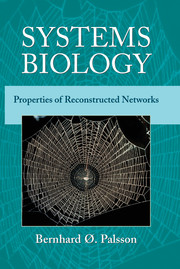Book contents
- Frontmatter
- Contents
- Preface
- 1 Introduction
- 2 Basic Concepts in Systems Biology
- PART I RECONSTRUCTION OF BIOCHEMICAL NETWORKS
- PART II MATHEMATICAL REPRESENTATION OF RECONSTRUCTED NETWORKS
- 6 Basic Features of the Stoichiometric Matrix
- 7 Topological Properties
- 8 Fundamental Subspaces of S
- 9 The (Right) Null Space of S
- 10 The Left Null Space of S
- 11 The Row and Column Spaces of S
- PART III CAPABILITIES OF RECONSTRUCTED NETWORKS
- APPENDIX A Nomenclature and Abbreviations
- APPENDIX B E. coli Core Metabolic Network
- Bibliography
- Index
8 - Fundamental Subspaces of S
from PART II - MATHEMATICAL REPRESENTATION OF RECONSTRUCTED NETWORKS
Published online by Cambridge University Press: 05 September 2012
- Frontmatter
- Contents
- Preface
- 1 Introduction
- 2 Basic Concepts in Systems Biology
- PART I RECONSTRUCTION OF BIOCHEMICAL NETWORKS
- PART II MATHEMATICAL REPRESENTATION OF RECONSTRUCTED NETWORKS
- 6 Basic Features of the Stoichiometric Matrix
- 7 Topological Properties
- 8 Fundamental Subspaces of S
- 9 The (Right) Null Space of S
- 10 The Left Null Space of S
- 11 The Row and Column Spaces of S
- PART III CAPABILITIES OF RECONSTRUCTED NETWORKS
- APPENDIX A Nomenclature and Abbreviations
- APPENDIX B E. coli Core Metabolic Network
- Bibliography
- Index
Summary
In the last chapter we discussed the elementary topological properties of the network that the stoichiometric matrix represents. In this chapter we look deeper into the properties of the stoichiometric matrix and how these fundamental topological properties can be used to obtain a more thorough understanding of the reaction network that it represents. This material is perhaps the most mathematical part of this book. It should be readily accessible to readers with formal education in the physical and engineering sciences, while readers with a life science background may find it challenging. The concepts introduced are important to the rest of the chapters in Part II. The stoichiometric matrix is a mathematical mapping operation (recall Figure 6.1). Matrices have certain fundamental properties that describe this mapping operation. These properties are contained in the four fundamental subspaces associated with a matrix. This chapter discusses these subspaces and how we can mathematically define them and interpret their contents in biochemical and biological terms.
Dimensions of the Fundamental Subspaces
The mapping that the stoichiometric matrix represents was illustrated in Figure 6.1 and a preliminary discussion of the associated four subspaces is found in Chapter 6. The stoichiometric matrix is typically rank deficient. The rank r of a matrix denotes the number of linearly independent rows and columns that the matrix contains. Rows are linearly dependent if any one row can be computed as a linear combination of the other rows.
- Type
- Chapter
- Information
- Systems BiologyProperties of Reconstructed Networks, pp. 118 - 135Publisher: Cambridge University PressPrint publication year: 2006



